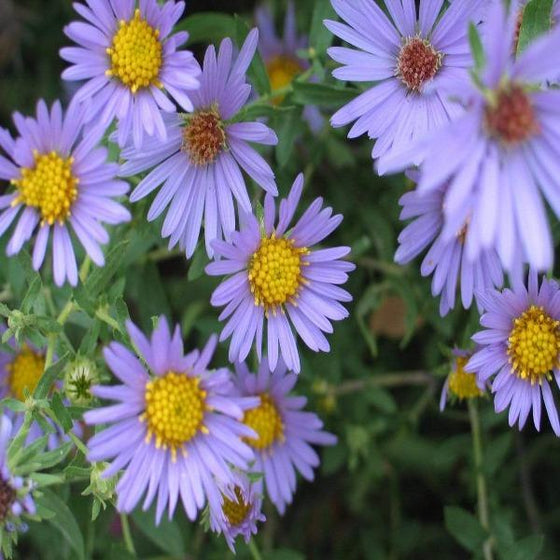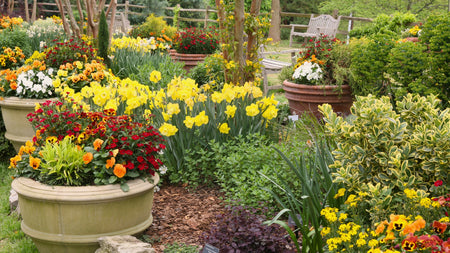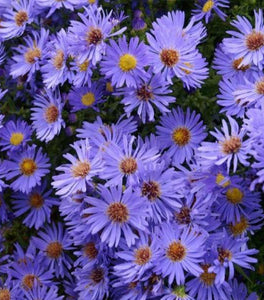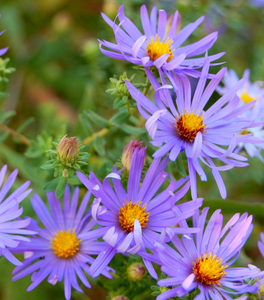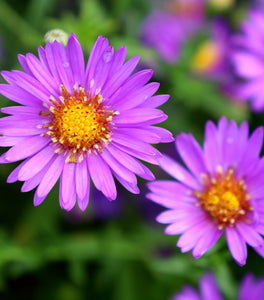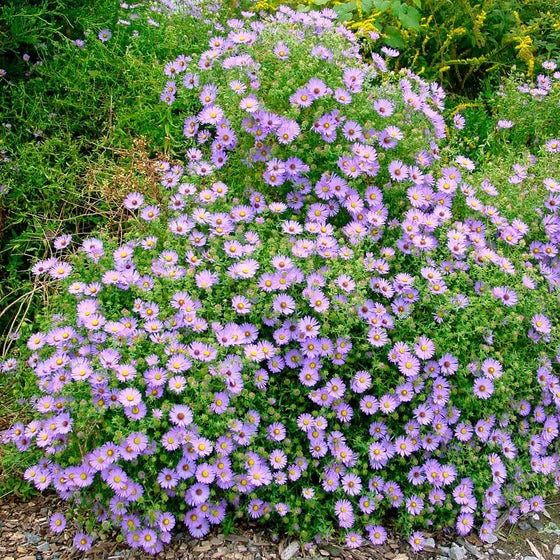
Images Depict Mature Plants
Buy Aster ‘October Skies’ | Compact Native Fall Aster | Garden Goods Direct
A burst of color when you need it most.
Bring your garden to life with Aster ‘October Skies’, a compact, native perennial that fills the late-season landscape with a sea of lavender-blue, daisy-like flowers. Blooming from late August through October, this aromatic aster adds reliable color and texture when many summer perennials have finished flowering. Its fragrant foliage and long-lasting blossoms make it a favorite among gardeners and pollinators alike.
Compact size with bold impact.
Reaching just 18 to 24 inches tall, ‘October Skies’ forms a dense, mounded habit perfect for the front of borders, cottage gardens, or pollinator patches. Its sky-blue blooms sit atop tidy green foliage, creating a striking contrast that brightens any sunny or partially shaded space. Unlike taller asters that tend to flop, this variety keeps a neat, compact form without staking or heavy maintenance.
Tough, drought-tolerant, and deer-resistant.
Aster ‘October Skies’ thrives in full sun and well-drained soil but tolerates a range of conditions, including dry sites and poor soils once established. Its aromatic foliage naturally repels deer and rabbits, making it ideal for low-maintenance, deer-resistant landscapes. This hardy perennial also attracts butterflies, bees, and late-season pollinators, making it a valuable addition to eco-friendly gardens.
A native perennial built for beauty and resilience.
Recognized for its outstanding performance by native plant trials, ‘October Skies’ is a durable, long-lived perennial that comes back stronger each year. Its combination of compact growth, pollinator appeal, and months of bloom makes it one of the best asters for fall planting. Whether you’re filling containers, designing a native border, or refreshing a fall garden bed, Aster ‘October Skies’ delivers color, fragrance, and reliability.
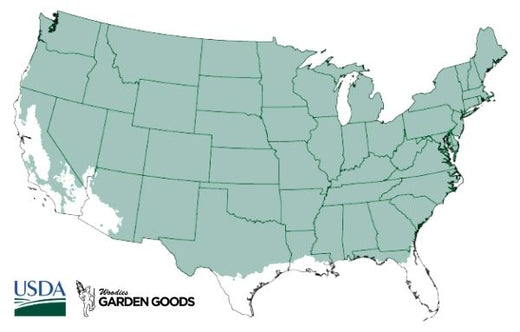
| Hardiness Zone: | 3-8 |
|---|---|
| Mature Height: | 1.5 to 2 feet |
| Mature Width: | 2 to 3 feet |
| Classification: | Flowering Perennial |
| Sunlight: | Full Sun to light shade |
| Habit: | Upright, clump forming |
| Flower Color: | Lavender blue |
| Flowering Season: | Mid Fall to late fall |
| Foliage: | Green-gray, sweetly scented |
| Soil Condition: | Prefers dry, average to slightly moist soil, wont tolerate wet soil in winter |
| Water Requirements: | Water well until established. |
| Uses: | Extremely attractive when used as a focal point in the mixed border, mass planting. Attracts pollinators. |
How to Care for Aster October Skies
Before you buy a Aster October Skies Plant, make sure to read about the recommended care instructions to keep this plant healthy and thriving.
How should I plant Aster ‘October Skies’?
Choose a sunny location with well-draining soil to plant your Aster ‘October Skies’. Dig a hole twice as wide as the root ball and the same depth, then position the plant so the crown is level with the soil surface. Backfill, firm the soil gently, and water thoroughly to help roots establish. Once planted, apply a thin layer of mulch to help retain soil moisture and prevent weeds. This hardy perennial quickly establishes and begins producing vibrant blue blooms in its first growing season.
How should I water Aster ‘October Skies’?
Water newly planted Asters regularly for the first few weeks to help roots develop. Once established, ‘October Skies’ becomes drought tolerant and needs only occasional deep watering during extended dry spells. Avoid overwatering or letting the soil remain soggy. A good rule of thumb is to water deeply once per week during hot, dry periods. Mulching around the base will help the soil retain consistent moisture while keeping roots cool.
How should I fertilize Aster ‘October Skies’?
Feed your Aster ‘October Skies’ in early spring with a balanced, slow-release fertilizer or a thin layer of organic compost. This provides steady nutrients for strong growth and abundant blooms. Avoid high-nitrogen fertilizers that can promote excess leaf growth at the expense of flowers. Because this perennial is low-maintenance and adaptable, one light feeding per year is usually enough. Healthy soil and proper sunlight will keep your asters thriving season after season.

How and when should I prune or deadhead Aster ‘October Skies’?
Prune back Aster ‘October Skies’ by one-third in early summer to encourage denser growth and more blooms in fall. Deadhead spent flowers during the blooming season to extend color and maintain a tidy appearance. After the first frost, cut back the plant to about 3 inches above the ground, or leave the stems standing through winter for birdseed and structure. New growth will emerge each spring for another season of vibrant fall color.

